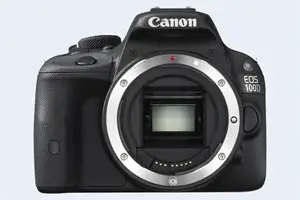Canon 100D vs Olympus E-3
The Canon EOS 100D (called Canon SL1 in some regions) and the Olympus E-3 are two digital cameras that were announced, respectively, in March 2013 and October 2007. Both are DSLR (Digital Single Lens Reflex) cameras that are based on an APS-C (100D) and a Four Thirds (E-3) sensor. The Canon has a resolution of 17.9 megapixels, whereas the Olympus provides 10 MP.
Below is an overview of the main specs of the two cameras as a starting point for the comparison.

Check 100D offers at
ebay.com

Check E-3 offers at
ebay.com
Going beyond this snapshot of core features and characteristics, what are the differences between the Canon EOS 100D and the Olympus E-3? Which one should you buy? Read on to find out how these two cameras compare with respect to their body size, their imaging sensors, their shooting features, their input-output connections, and their reception by expert reviewers.
Body comparison
The physical size and weight of the Canon 100D and the Olympus E-3 are illustrated in the side-by-side display below. The two cameras are presented according to their relative size. Three consecutive perspectives from the front, the top, and the back are available. All width, height and depth measures are rounded to the nearest millimeter.
The 100D can be obtained in two different colors (black, white), while the E-3 is only available in black.
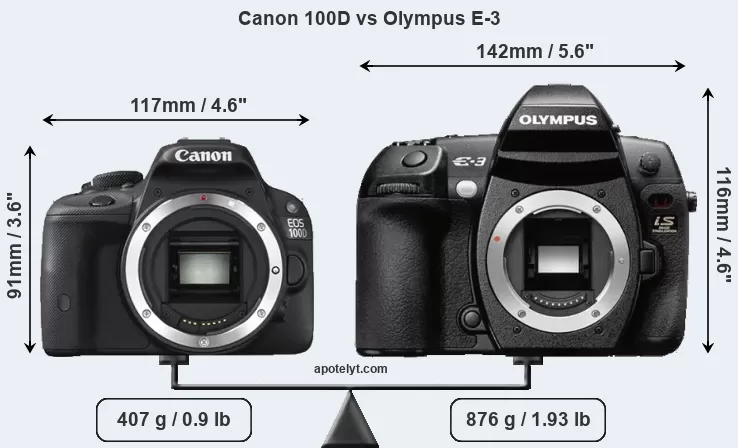
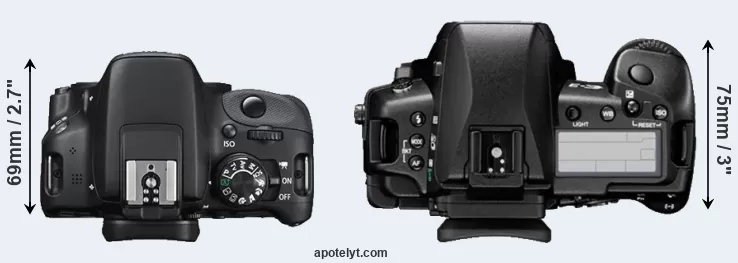
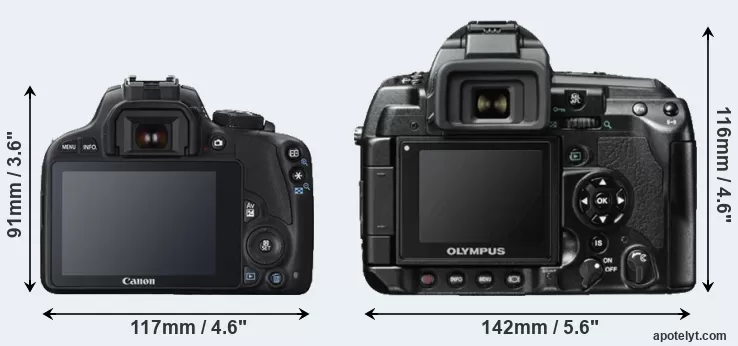
If the front view area (width x height) of the cameras is taken as an aggregate measure of their size, the Olympus E-3 is considerably larger (55 percent) than the Canon 100D. Moreover, the E-3 is substantially heavier (115 percent) than the 100D. It is noteworthy in this context that the E-3 is splash and dust-proof, while the 100D does not feature any corresponding weather-sealing.
The above size and weight comparisons are to some extent incomplete since they do not consider the interchangeable lenses that both of these cameras require. A larger imaging sensor will tend to go along with bigger and heavier lenses, although exceptions exist. You can compare the optics available for the two cameras in the Canon EF Lens Catalog (100D) and the Four Thirds Lens Catalog (E-3).
Concerning battery life, the 100D gets 380 shots out of its Canon LP-E12 battery, while the E-3 can take 750 images on a single charge of its Olympus BLM-1 power pack.
The table below summarizes the key physical specs of the two cameras alongside a broader set of comparators. If you want to switch the focus of the display and review another camera pair, you can move across to the CAM-parator tool and choose from the broad selection of possible camera comparisons there.

| # | Camera Model |
Camera Width |
Camera Height |
Camera Depth |
Camera Weight |
Battery Life |
Weather Sealing |
Camera Launch |
Launch Price (USD) |
Street Price |
|
|---|---|---|---|---|---|---|---|---|---|---|---|
| 1. | Canon 100D | 117 mm | 91 mm | 69 mm | 407 g | 380 | n | Mar 2013 | 549 | ebay.com | |
| 2. | Olympus E-3 | 142 mm | 116 mm | 75 mm | 876 g | 750 | Y | Oct 2007 | 1,699 | ebay.com | |
| 3. | Canon 4000D | 129 mm | 102 mm | 77 mm | 436 g | 500 | n | Feb 2018 | 399 | amazon.com | |
| 4. | Canon 200D | 122 mm | 93 mm | 70 mm | 453 g | 650 | n | Jun 2017 | 549 | ebay.com | |
| 5. | Canon 1300D | 129 mm | 101 mm | 78 mm | 485 g | 500 | n | Mar 2016 | 449 | ebay.com | |
| 6. | Canon 1200D | 130 mm | 100 mm | 78 mm | 480 g | 500 | n | Feb 2014 | 449 | ebay.com | |
| 7. | Canon 700D | 133 mm | 100 mm | 79 mm | 580 g | 440 | n | Mar 2013 | 649 | ebay.com | |
| 8. | Canon G16 | 109 mm | 76 mm | 40 mm | 356 g | 360 | n | Aug 2013 | 549 | ebay.com | |
| 9. | Canon 650D | 133 mm | 100 mm | 79 mm | 575 g | 440 | n | Jun 2012 | 849 | ebay.com | |
| 10. | Canon M | 109 mm | 66 mm | 32 mm | 298 g | 230 | n | Jul 2012 | 599 | ebay.com | |
| 11. | Canon 600D | 133 mm | 100 mm | 80 mm | 570 g | 440 | n | Feb 2011 | 599 | ebay.com | |
| 12. | Olympus E-5 | 142 mm | 117 mm | 75 mm | 873 g | 750 | Y | Sep 2010 | 1,699 | ebay.com | |
| 13. | Olympus E-30 | 142 mm | 108 mm | 75 mm | 701 g | 750 | n | Nov 2008 | 1,299 | ebay.com | |
| 14. | Olympus E-520 | 136 mm | 92 mm | 68 mm | 535 g | 750 | n | May 2008 | 699 | ebay.com | |
| 15. | Olympus E-510 | 136 mm | 92 mm | 68 mm | 538 g | 750 | n | Mar 2007 | 799 | ebay.com | |
| 16. | Olympus E-1 | 141 mm | 104 mm | 81 mm | 738 g | 750 | Y | Jun 2003 | 1,699 | ebay.com | |
| 17. | Panasonic G6 | 122 mm | 85 mm | 71 mm | 390 g | 340 | n | Apr 2013 | 599 | ebay.com | |
| Note: Measurements and pricing do not include easily detachable parts, such as add-on or interchangeable lenses or optional viewfinders. | |||||||||||
Any camera decision will obviously take relative prices into account. The manufacturer’s suggested retail prices give an idea on the placement of the camera in the maker’s lineup and the broader market. The 100D was launched at a markedly lower price (by 68 percent) than the E-3, which puts it into a different market segment. Usually, retail prices stay at first close to the launch price, but after several months, discounts become available. Later in the product cycle and, in particular, when the replacement model is about to appear, further discounting and stock clearance sales often push the camera price considerably down. Then, after the new model is out, very good deals can frequently be found on the pre-owned market.
Sensor comparison
The size of the sensor inside a digital camera is one of the key determinants of image quality. A large sensor will tend to have larger individual pixels that provide better low-light sensitivity, wider dynamic range, and richer color-depth than smaller pixel-units in a sensor of the same technological generation. Further, a large sensor camera will give the photographer additional creative options when using shallow depth-of-field to isolate a subject from its background. On the downside, larger sensors tend to be more expensive and lead to bigger and heavier cameras and lenses.
Of the two cameras under consideration, the Canon 100D features an APS-C sensor and the Olympus E-3 a Four Thirds sensor. The sensor area in the E-3 is 32 percent smaller. As a result of these sensor size differences, the cameras have a format factor of, respectively, 1.6 and 2.0. The sensor in the 100D has a native 3:2 aspect ratio, while the one in the E-3 offers a 4:3 aspect.
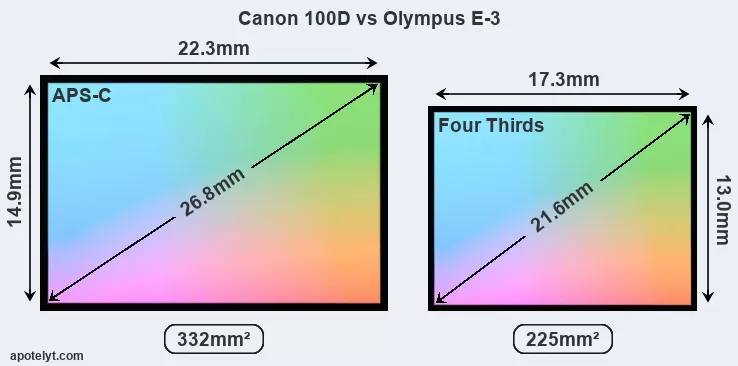
With 17.9MP, the 100D offers a higher resolution than the E-3 (10MP), but the 100D has smaller individual pixels (pixel pitch of 4.31μm versus 4.74μm for the E-3). However, the 100D is a much more recent model (by 5 years and 5 months) than the E-3, and its sensor will have benefitted from technological advances during this time that enhance the light gathering capacity of its pixels.
The resolution advantage of the Canon 100D implies greater flexibility for cropping images or the possibility to print larger pictures. The maximum print size of the 100D for good quality output (200 dots per inch) amounts to 25.9 x 17.3 inches or 65.8 x 43.9 cm, for very good quality (250 dpi) 20.7 x 13.8 inches or 52.7 x 35.1 cm, and for excellent quality (300 dpi) 17.3 x 11.5 inches or 43.9 x 29.3 cm. The corresponding values for the Olympus E-3 are 18.2 x 13.7 inches or 46.3 x 34.7 cm for good quality, 14.6 x 10.9 inches or 37.1 x 27.8 cm for very good quality, and 12.2 x 9.1 inches or 30.9 x 23.2 cm for excellent quality prints.
The 100D has on-sensor phase detect pixels, which results in fast and reliable autofocus acquisition even during live view operation.
The Canon EOS 100D has a native sensitivity range from ISO 100 to ISO 12800, which can be extended to ISO 100-25600. The corresponding ISO settings for the Olympus E-3 are ISO 100 to ISO 3200 (no boost).
Technology-wise, both cameras are equipped with CMOS (Complementary Metal–Oxide–Semiconductor) sensors. Both cameras use a Bayer filter for capturing RGB colors on a square grid of photosensors. This arrangement is found in most digital cameras.
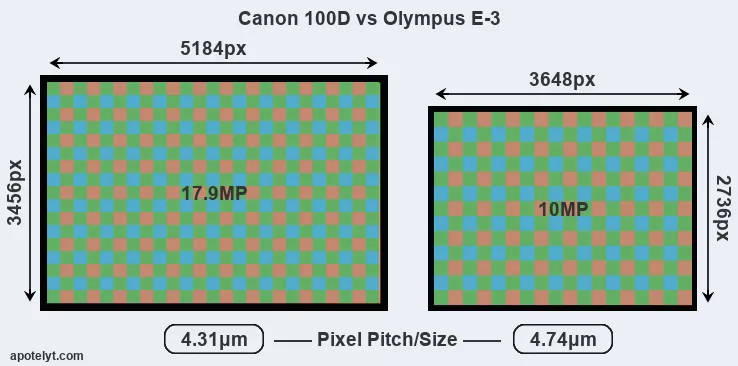
Since 2007, DXO Mark has published sensor performance measurements that have been derived using a consistent methodology. This service is based on lab testing and assigns an overall score to each camera sensor, as well as ratings for dynamic range ("DXO Landscape"), color depth ("DXO Portrait"), and low-light sensitivity ("DXO Sports"). Of the two cameras under review, the 100D has a notably higher overall DXO score than the E-3 (overall score 7 points higher), which gives it an advantage in terms of imaging quality. This advantage is based on 0.2 bits higher color depth, 0.8 EV in additional dynamic range, and 0.6 stops in additional low light sensitivity. The adjacent table reports on the physical sensor characteristics and the outcomes of the DXO sensor quality tests for a sample of comparator-cameras.

| # | Camera Model |
Sensor Class |
Resolution (MP) |
Horiz. Pixels |
Vert. Pixels |
Video Format |
DXO Portrait |
DXO Landscape |
DXO Sports |
DXO Overall |
|
|---|---|---|---|---|---|---|---|---|---|---|---|
| 1. | Canon 100D | APS-C | 17.9 | 5184 | 3456 | 1080/30p | 21.8 | 11.3 | 843 | 63 | |
| 2. | Olympus E-3 | Four Thirds | 10.0 | 3648 | 2736 | none | 21.6 | 10.5 | 571 | 56 | |
| 3. | Canon 4000D | APS-C | 17.9 | 5184 | 3456 | 1080/30p | 21.9 | 11.4 | 695 | 63 | |
| 4. | Canon 200D | APS-C | 24.0 | 6000 | 4000 | 1080/60p | 23.6 | 13.4 | 1041 | 79 | |
| 5. | Canon 1300D | APS-C | 17.9 | 5184 | 3456 | 1080/30p | 22.0 | 11.7 | 781 | 66 | |
| 6. | Canon 1200D | APS-C | 17.9 | 5184 | 3456 | 1080/30p | 21.9 | 11.3 | 724 | 63 | |
| 7. | Canon 700D | APS-C | 17.9 | 5184 | 3456 | 1080/30p | 21.7 | 11.2 | 681 | 61 | |
| 8. | Canon G16 | 1/1.7 | 12.0 | 4000 | 3000 | 1080/60p | 21.0 | 11.7 | 230 | 54 | |
| 9. | Canon 650D | APS-C | 17.9 | 5184 | 3456 | 1080/30p | 21.7 | 11.2 | 722 | 62 | |
| 10. | Canon M | APS-C | 17.9 | 5184 | 3456 | 1080/30p | 22.1 | 11.2 | 827 | 65 | |
| 11. | Canon 600D | APS-C | 17.9 | 5184 | 3456 | 1080/30p | 22.1 | 11.5 | 793 | 65 | |
| 12. | Olympus E-5 | Four Thirds | 12.2 | 4032 | 3024 | 720/30p | 21.6 | 10.5 | 519 | 56 | |
| 13. | Olympus E-30 | Four Thirds | 12.2 | 4032 | 3024 | none | 21.3 | 10.4 | 530 | 55 | |
| 14. | Olympus E-520 | Four Thirds | 10.0 | 3648 | 2736 | none | 21.4 | 10.4 | 548 | 55 | |
| 15. | Olympus E-510 | Four Thirds | 10.0 | 3648 | 2736 | none | 21.2 | 10.0 | 442 | 52 | |
| 16. | Olympus E-1 | Four Thirds | 4.9 | 2560 | 1920 | none | 20.0 | 9.7 | -145 | 44 | |
| 17. | Panasonic G6 | Four Thirds | 15.9 | 4608 | 3456 | 1080/60p | 21.3 | 11.5 | 639 | 61 | |
| Note: DXO values in italics represent estimates based on sensor size and age. | |||||||||||
Many modern cameras cannot only take still pictures, but also record videos. The 100D indeed provides movie recording capabilities, while the E-3 does not. The highest resolution format that the 100D can use is 1080/30p.
Feature comparison
Apart from body and sensor, cameras can and do differ across a variety of features. The 100D and the E-3 are similar in the sense that both have an optical viewfinder. The latter is useful for getting a clear image for framing even in brightly lit environments. The viewfinder in the E-3 offers a wider field of view (100%) than the one in the 100D (95%), so that a larger proportion of the captured image is visible in the finder. In addition, the viewfinder of the E-3 has a higher magnification (0.58x vs 0.54x), so that the size of the image transmitted appears closer to the size seen with the naked human eye. The table below summarizes some of the other core capabilities of the Canon 100D and Olympus E-3 in connection with corresponding information for a sample of similar cameras.

| # | Camera Model |
Viewfinder (Type or 000 dots) |
Control Panel (yes/no) |
LCD Specifications (inch/000 dots) |
LCD Attach- ment |
Touch Screen (yes/no) |
Max Shutter Speed * |
Max Shutter Flaps * |
Built-in Flash (yes/no) |
Built-in Image Stab |
|
|---|---|---|---|---|---|---|---|---|---|---|---|
| 1. | Canon 100D | optical | n | 3.0 / 1040 | fixed | Y | 1/4000s | 4.9/s | Y | n | |
| 2. | Olympus E-3 | optical | Y | 2.5 / 230 | swivel | n | 1/8000s | 5.0/s | Y | Y | |
| 3. | Canon 4000D | optical | n | 2.7 / 230 | fixed | n | 1/4000s | 3.0/s | Y | n | |
| 4. | Canon 200D | optical | n | 3.0 / 1040 | swivel | Y | 1/4000s | 5.0/s | Y | n | |
| 5. | Canon 1300D | optical | n | 3.0 / 920 | fixed | n | 1/4000s | 3.0/s | Y | n | |
| 6. | Canon 1200D | optical | n | 3.0 / 460 | fixed | n | 1/4000s | 3.0/s | Y | n | |
| 7. | Canon 700D | optical | n | 3.0 / 1040 | swivel | Y | 1/4000s | 5.0/s | Y | n | |
| 8. | Canon G16 | optical | n | 3.0 / 922 | fixed | n | 1/4000s | 2.2/s | Y | Y | |
| 9. | Canon 650D | optical | n | 3.0 / 1040 | swivel | Y | 1/4000s | 5.0/s | Y | n | |
| 10. | Canon M | none | n | 3.0 / 1040 | fixed | Y | 1/4000s | 4.3/s | n | n | |
| 11. | Canon 600D | optical | n | 3.0 / 1040 | swivel | n | 1/4000s | 3.7/s | Y | n | |
| 12. | Olympus E-5 | optical | Y | 3.0 / 920 | swivel | n | 1/8000s | 5.0/s | Y | Y | |
| 13. | Olympus E-30 | optical | Y | 2.7 / 230 | swivel | n | 1/8000s | 5.0/s | Y | Y | |
| 14. | Olympus E-520 | optical | n | 2.7 / 215 | fixed | n | 1/4000s | 3.5/s | Y | Y | |
| 15. | Olympus E-510 | optical | n | 2.5 / 215 | fixed | n | 1/4000s | 3.0/s | Y | Y | |
| 16. | Olympus E-1 | optical | Y | 1.8 / 134 | fixed | n | 1/4000s | 3.0/s | n | n | |
| 17. | Panasonic G6 | 1440 | n | 3.0 / 1036 | swivel | Y | 1/4000s | 7.0/s | Y | n | |
| Note: *) Information refers to the mechanical shutter, unless the camera only has an electronic one. | |||||||||||
One differentiating feature between the two cameras concerns the touch sensitivity of the rear screen. The 100D has a touchscreen, while the E-3 has a conventional panel. Touch control can be particularly helpful, for example, for setting the focus point.
The E-3 has an articulated screen that can be turned to be front-facing. This characteristic will be appreciated by vloggers and photographers who are interested in taking selfies. In contrast, the 100D does not have a selfie-screen.The 100D writes its imaging data to SDXC cards, while the E-3 uses Compact Flash or xD Picture cards. The E-3 features dual card slots, which can be very useful in case a memory card fails. In contrast, the 100D only has one slot.
Connectivity comparison
For some imaging applications, the extent to which a camera can communicate with its environment can be an important aspect in the camera decision process. The table below provides an overview of the connectivity of the Canon EOS 100D and Olympus E-3 and, in particular, the interfaces the cameras (and selected comparators) provide for accessory control and data transfer.

| # | Camera Model |
Hotshoe Port |
Internal Mic / Speaker |
Microphone Port |
Headphone Port |
HDMI Port |
USB Port |
WiFi Support |
NFC Support |
Bluetooth Support |
|
|---|---|---|---|---|---|---|---|---|---|---|---|
| 1. | Canon 100D | Y | mono / mono | Y | - | mini | 2.0 | - | - | - | |
| 2. | Olympus E-3 | Y | - / - | - | - | - | 2.0 | - | - | - | |
| 3. | Canon 4000D | Y | mono / mono | - | - | mini | 2.0 | Y | Y | - | |
| 4. | Canon 200D | Y | stereo / mono | Y | - | mini | 2.0 | Y | Y | Y | |
| 5. | Canon 1300D | Y | mono / mono | - | - | mini | 2.0 | Y | Y | - | |
| 6. | Canon 1200D | Y | mono / mono | - | - | mini | 2.0 | - | - | - | |
| 7. | Canon 700D | Y | stereo / mono | Y | - | mini | 2.0 | - | - | - | |
| 8. | Canon G16 | Y | stereo / mono | - | - | mini | 2.0 | Y | - | - | |
| 9. | Canon 650D | Y | stereo / mono | Y | - | mini | 2.0 | - | - | - | |
| 10. | Canon M | Y | stereo / mono | Y | - | mini | 2.0 | - | - | - | |
| 11. | Canon 600D | Y | mono / mono | Y | - | mini | 2.0 | - | - | - | |
| 12. | Olympus E-5 | Y | stereo / - | - | - | mini | 2.0 | - | - | - | |
| 13. | Olympus E-30 | Y | - / - | - | - | - | 2.0 | - | - | - | |
| 14. | Olympus E-520 | Y | - / - | - | - | - | 2.0 | - | - | - | |
| 15. | Olympus E-510 | Y | - / - | - | - | - | 2.0 | - | - | - | |
| 16. | Olympus E-1 | Y | - / - | - | - | - | 2.0 | - | - | - | |
| 17. | Panasonic G6 | Y | stereo / mono | Y | - | mini | 2.0 | Y | Y | - |
Studio photographers will appreciate that the Olympus E-3 (unlike the 100D) features a PC Sync socket, so that professional strobe lights can be controlled by the camera.
Both the 100D and the E-3 have been discontinued, but can regularly be found used on ebay. The E-3 was replaced by the Olympus E-5, while the 100D was followed by the Canon 200D. Further information on the features and operation of the 100D and E-3 can be found, respectively, in the Canon 100D Manual (free pdf) or the online Olympus E-3 Manual.
Review summary
So what conclusions can be drawn? Which of the two cameras – the Canon 100D or the Olympus E-3 – has the upper hand? Is one clearly better than the other? A synthesis of the relative strong points of each of the models is listed below.

Reasons to prefer the Canon EOS 100D:
- More detail: Offers more megapixels (17.9 vs 10MP) with a 37% higher linear resolution.
- Better image quality: Scores markedly higher (7 points) in the DXO overall assessment.
- More dynamic range: Captures a larger spectrum of light and dark details (0.8 EV of extra DR).
- Better low-light sensitivity: Requires less light for good images (0.6 stops ISO advantage).
- Broader imaging potential: Can record not only still images but also 1080/30p movies.
- Better live-view autofocus: Features on-sensor phase-detection for more confident autofocus.
- Larger screen: Has a bigger rear LCD (3.0" vs 2.5") for image review and settings control.
- More detailed LCD: Has a higher resolution rear screen (1040k vs 230k dots).
- Fewer buttons to press: Is equipped with a touch-sensitive rear screen to facilitate handling.
- More compact: Is smaller (117x91mm vs 142x116mm) and thus needs less room in the bag.
- Less heavy: Is lighter (by 469g or 54 percent) and hence easier to carry around.
- More affordable: Was introduced into a lower priced category (68 percent cheaper at launch).
- More modern: Reflects 5 years and 5 months of technical progress since the E-3 launch.

Advantages of the Olympus E-3:
- More complete view: Has a viewfinder with a larger field of view (100% vs 95%).
- Larger viewfinder image: Features a viewfinder with a higher magnification (0.58x vs 0.54x).
- Easier setting verification: Features a control panel on top to check shooting parameters.
- More flexible LCD: Has a swivel screen for odd-angle shots in portrait or landscape orientation.
- More selfie-friendly: Has an articulated screen that can be turned to be front-facing.
- Faster shutter: Has higher mechanical shutter speed (1/8000s vs 1/4000s) to freeze action.
- Longer lasting: Gets more shots (750 versus 380) out of a single battery charge.
- Better sealing: Is splash and dust sealed for shooting in inclement weather conditions.
- Sharper images: Has stabilization technology built-in to reduce the impact of hand-shake.
- Better studio light control: Has a PC Sync socket to connect to professional strobe lights.
- Greater peace of mind: Features a second card slot as a backup in case of memory card failure.
- More heavily discounted: Has been around for much longer (launched in October 2007).
If the count of relative strengths (bullet points above) is taken as a measure, the 100D comes out slightly ahead of the E-3 (13 : 12 points). However, the pertinence of the various camera strengths will differ across photographers, so that you might want to weigh individual camera traits according to their importance for your own imaging needs before making a camera decision. A professional wildlife photographer will view the differences between cameras in a way that diverges from the perspective of a family photog, and a person interested in architecture has distinct needs from a sports shooter. Hence, the decision which camera is best and worth buying is often a very personal one.
How about other alternatives? Do the specifications of the Canon 100D and the Olympus E-3 place the cameras among the top in their class? Find out in the latest Best DSLR Camera listing whether the two cameras rank among the cream of the crop.
In any case, while the comparison of technical specifications can provide a useful overview of the capabilities of different cameras, it remains incomplete and does no justice, for example, to the way the 100D or the E-3 perform in practice. User reviews that are available, for instance, at amazon can sometimes shed light on these issues, but such feedback is all too often partial, inconsistent, and inaccurate.
Expert reviews
This is where reviews by experts come in. The adjacent summary-table relays the overall verdicts of several of the most popular camera review sites (amateurphotographer [AP], cameralabs [CL], digitalcameraworld [DCW], dpreview [DPR], ephotozine [EPZ], photographyblog [PB]). As can be seen, the professional reviewers agree in many cases on the quality of different cameras, but sometimes their assessments diverge, reinforcing the earlier point that a camera decision is often a very personal choice.

| # | Camera Model |
AP score |
CL score |
DCW score |
DPR score |
EPZ score |
PB score |
Camera Launch |
Launch Price (USD) |
Street Price |
|
|---|---|---|---|---|---|---|---|---|---|---|---|
| 1. | Canon 100D | 4/5 | + | .. | 78/100 | 4/5 | 4/5 | Mar 2013 | 549 | ebay.com | |
| 2. | Olympus E-3 | .. | 88/100 | .. | + + | o | 4/5 | Oct 2007 | 1,699 | ebay.com | |
| 3. | Canon 4000D | 2.5/5 | o | 3/5 | .. | 3.5/5 | 3.5/5 | Feb 2018 | 399 | amazon.com | |
| 4. | Canon 200D | 4/5 | + + | 4/5 | 78/100 | 4.5/5 | 4.5/5 | Jun 2017 | 549 | ebay.com | |
| 5. | Canon 1300D | 4/5 | o | 4/5 | 73/100 | 4/5 | 4/5 | Mar 2016 | 449 | ebay.com | |
| 6. | Canon 1200D | 3/5 | + | .. | .. | 4/5 | 4.5/5 | Feb 2014 | 449 | ebay.com | |
| 7. | Canon 700D | .. | .. | .. | 76/100 | 4.5/5 | 4.5/5 | Mar 2013 | 649 | ebay.com | |
| 8. | Canon G16 | 4/5 | + | .. | .. | 4.5/5 | 4.5/5 | Aug 2013 | 549 | ebay.com | |
| 9. | Canon 650D | 4/5 | + + | .. | 77/100 | 4.5/5 | 4.5/5 | Jun 2012 | 849 | ebay.com | |
| 10. | Canon M | 3/5 | + | .. | .. | 4/5 | 4/5 | Jul 2012 | 599 | ebay.com | |
| 11. | Canon 600D | 3/5 | o | .. | 77/100 | 4.5/5 | 4.5/5 | Feb 2011 | 599 | ebay.com | |
| 12. | Olympus E-5 | 4/5 | .. | .. | 75/100 | 4/5 | 4.5/5 | Sep 2010 | 1,699 | ebay.com | |
| 13. | Olympus E-30 | .. | .. | .. | 71/100 | 4.5/5 | 4/5 | Nov 2008 | 1,299 | ebay.com | |
| 14. | Olympus E-520 | .. | 87/100 | .. | + + | 4.5/5 | 4.5/5 | May 2008 | 699 | ebay.com | |
| 15. | Olympus E-510 | .. | 89/100 | .. | + + | 3.5/5 | 4.5/5 | Mar 2007 | 799 | ebay.com | |
| 16. | Olympus E-1 | .. | .. | .. | + | o | .. | Jun 2003 | 1,699 | ebay.com | |
| 17. | Panasonic G6 | 4/5 | + + | .. | .. | 5/5 | 4.5/5 | Apr 2013 | 599 | ebay.com | |
| Note: (+ +) highly recommended; (+) recommended; (o) reviewed; (..) not available. | |||||||||||
The review scores listed above should be treated with care, though. The ratings are only valid when referring to cameras in the same category and of the same age. A score, therefore, has to be seen in close connection to the price and market introduction time of the camera, and rating-comparisons among cameras that span long time periods or concern very differently equipped models make little sense. Also, please note that some of the review sites have changed their methodology and reporting over time.

Check 100D offers at
ebay.com

Check E-3 offers at
ebay.com
Other camera comparisons
Did this review help to inform your camera decision process? In case you are interested in seeing how other cameras pair up, just make your choice using the following search menu. Alternatively, you can follow any of the listed hyperlinks for comparisons that others found interesting.
- Canon 100D vs Canon 450D
- Canon 100D vs Canon G12
- Canon 100D vs Fujifilm X-A3
- Canon 100D vs Leica V-LUX 4
- Canon 100D vs Panasonic FZ1000
- Canon 100D vs Sony RX10 IV
- Canon 20D vs Olympus E-3
- Nikon 1 V2 vs Olympus E-3
- Nikon D500 vs Olympus E-3
- Olympus E-3 vs Olympus E-510
- Olympus E-3 vs Olympus E-M1 III
- Olympus E-3 vs Ricoh GR III
Specifications: Canon 100D vs Olympus E-3
Below is a side-by-side comparison of the specs of the two cameras to facilitate a quick review of their differences and common features.
| Camera Model | Canon 100D | Olympus E-3 |
|---|---|---|
| Camera Type | Digital single lens reflex | Digital single lens reflex |
| Camera Lens | Canon EF mount lenses | Four Thirds lenses |
| Launch Date | March 2013 | October 2007 |
| Launch Price | USD 549 | USD 1,699 |
| Sensor Specs | Canon 100D | Olympus E-3 |
| Sensor Technology | CMOS | CMOS |
| Sensor Format | APS-C Sensor | Four Thirds Sensor |
| Sensor Size | 22.3 x 14.9 mm | 17.3 x 13.0 mm |
| Sensor Area | 332.27 mm2 | 224.9 mm2 |
| Sensor Diagonal | 26.8 mm | 21.6 mm |
| Crop Factor | 1.6x | 2.0x |
| Sensor Resolution | 17.9 Megapixels | 10 Megapixels |
| Image Resolution | 5184 x 3456 pixels | 3648 x 2736 pixels |
| Pixel Pitch | 4.31 μm | 4.74 μm |
| Pixel Density | 5.39 MP/cm2 | 4.44 MP/cm2 |
| Moiré control | Anti-Alias filter | Anti-Alias filter |
| Movie Capability | 1080/30p Video | no Video |
| ISO Setting | 100 - 12,800 ISO | 100 - 3,200 ISO |
| ISO Boost | 100 - 25,600 ISO | no Enhancement |
| Image Processor | DIGIC 5 | TruePic III |
| DXO Sensor Quality (score) | 63 | 56 |
| DXO Color Depth (bits) | 21.8 | 21.6 |
| DXO Dynamic Range (EV) | 11.3 | 10.5 |
| DXO Low Light (ISO) | 843 | 571 |
| Screen Specs | Canon 100D | Olympus E-3 |
| Viewfinder Type | Optical viewfinder | Optical viewfinder |
| Viewfinder Field of View | 95% | 100% |
| Viewfinder Magnification | 0.54x | 0.58x |
| Top-Level Screen | no Top Display | Control Panel |
| LCD Framing | Live View | Live View |
| Rear LCD Size | 3.0inch | 2.5inch |
| LCD Resolution | 1040k dots | 230k dots |
| LCD Attachment | Fixed screen | Swivel screen |
| Touch Input | Touchscreen | no Touchscreen |
| Shooting Specs | Canon 100D | Olympus E-3 |
| Focus System | Phase-detect AF | Phase-detect AF |
| Continuous Shooting | 4.9 shutter flaps/s | 5 shutter flaps/s |
| Image Stabilization | Lens stabilization only | In-body stabilization |
| Fill Flash | Built-in Flash | Built-in Flash |
| Storage Medium | SDXC cards | CF or XD cards |
| Single or Dual Card Slots | Single card slot | Dual card slots |
| Connectivity Specs | Canon 100D | Olympus E-3 |
| External Flash | Hotshoe | Hotshoe |
| Studio Flash | no PC Sync | PC Sync socket |
| USB Connector | USB 2.0 | USB 2.0 |
| HDMI Port | mini HDMI | no HDMI |
| Microphone Port | External MIC port | no MIC socket |
| Wifi Support | no Wifi | no Wifi |
| Body Specs | Canon 100D | Olympus E-3 |
| Environmental Sealing | not weather sealed | Weathersealed body |
| Battery Type | Canon LP-E12 | Olympus BLM-1 |
| Battery Life (CIPA) | 380 shots per charge | 750 shots per charge |
| Body Dimensions |
117 x 91 x 69 mm (4.6 x 3.6 x 2.7 in) |
142 x 116 x 75 mm (5.6 x 4.6 x 3.0 in) |
| Camera Weight | 407 g (14.4 oz) | 876 g (30.9 oz) |

Check 100D offers at
ebay.com

Check E-3 offers at
ebay.com
Did you notice an error on this page? If so, please get in touch, so that we can correct the information.
